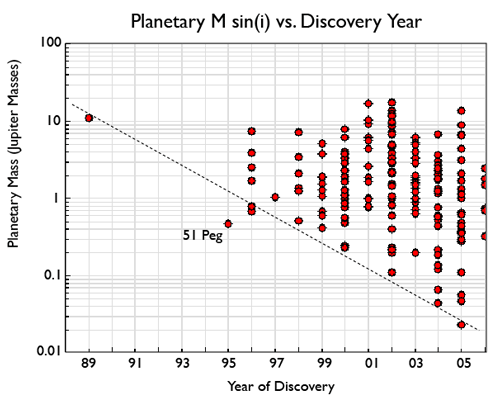2010
greg posted in exoplanet detection on April 19th, 2006

As I’ve mentioned earlier, Jean Schneider’s authoritative Extrasolar Planets Encyclopedia has introduced a slick .php-based approach that’s keeping the systemic team on their toes. At Schneider’s site, one can interactively produce correlation diagrams for the known extrasolar planets. As more planets are discovered, these diagrams (for example the a-e plot and the Msin(i)-a plot) are beginning to show a fascinating richness of detail.
The inclusion of date of discovery as one of the plottable parameters attracted my attention.
For example, a plot of the Log of the planetary period versus discovery date shows hints of interesting structure:

Over the past few years, the majority of newly detected planets can be divided into a population with P<10 days (the hot Jupiters), and a population with P>200 days (the eccentric giants). There is a statistically significant gap in the period distribution in the intermediate-period regime. This gap tells us something significant about the planet formation process. My interpretation is that the migration process is not readily halted until a planet reaches the region of the disk where the dyanamics of the protostellar disk gas are subject to the laws of ideal MHD. More on that later.
From a more practical standpoint, the paucity of intermediate period planets has made it tough going for the transitsearch.org collaboration. When planetary periods are less than about 10 days, the discovery team is usually able to complete a photometric search for transits before the planet is publicly announced. When a planetary period exceeds 200 days, it’s generally hopeless to mount an exhaustive transit search, even with a distributed network.
You’ll get another very interesting diagram if you plot the Log of the planetary mass as a function of discovery date. As usual, I’ve redone the axes and annotations with Adobe Illustrator to get that familiar oklo.org look-n-feel:

In this log-linear space, the lower envelope of detected planet mass is a linear function of time. This allows for an easy extrapolation to estimate the discovery date of the first Earth-mass planet orbiting a nearby main-sequence star…
November 20th, 2006 at 8:11 am
[…] The individual radial velocity uncertainties for the 1172 velocities the Challenge 004 datset are each of order 10 centimeters per second. Errors this small are still safely smaller than the sub-meter per second precision that is currently being obtained by the Swiss team (with HARPS) and the California Carnegie team (at Keck). Given the rapid improvement in the radial velocity technique over the past decade, however, it’s not at all unreasonable to expect instrumental precisions of 10 cm/s fairly soon. Many console users were able to extract the four largest-amplitude solar-system planets — Jupiter, Saturn, Earth, and Venus — out of the challenge004 dataset, suggesting that it’s only a matter of time before instrumental precisions and observational baselines arrive at the threshold where truly habitable, Earth-mass planets can be detected from the ground using the radial velocity technique. […]